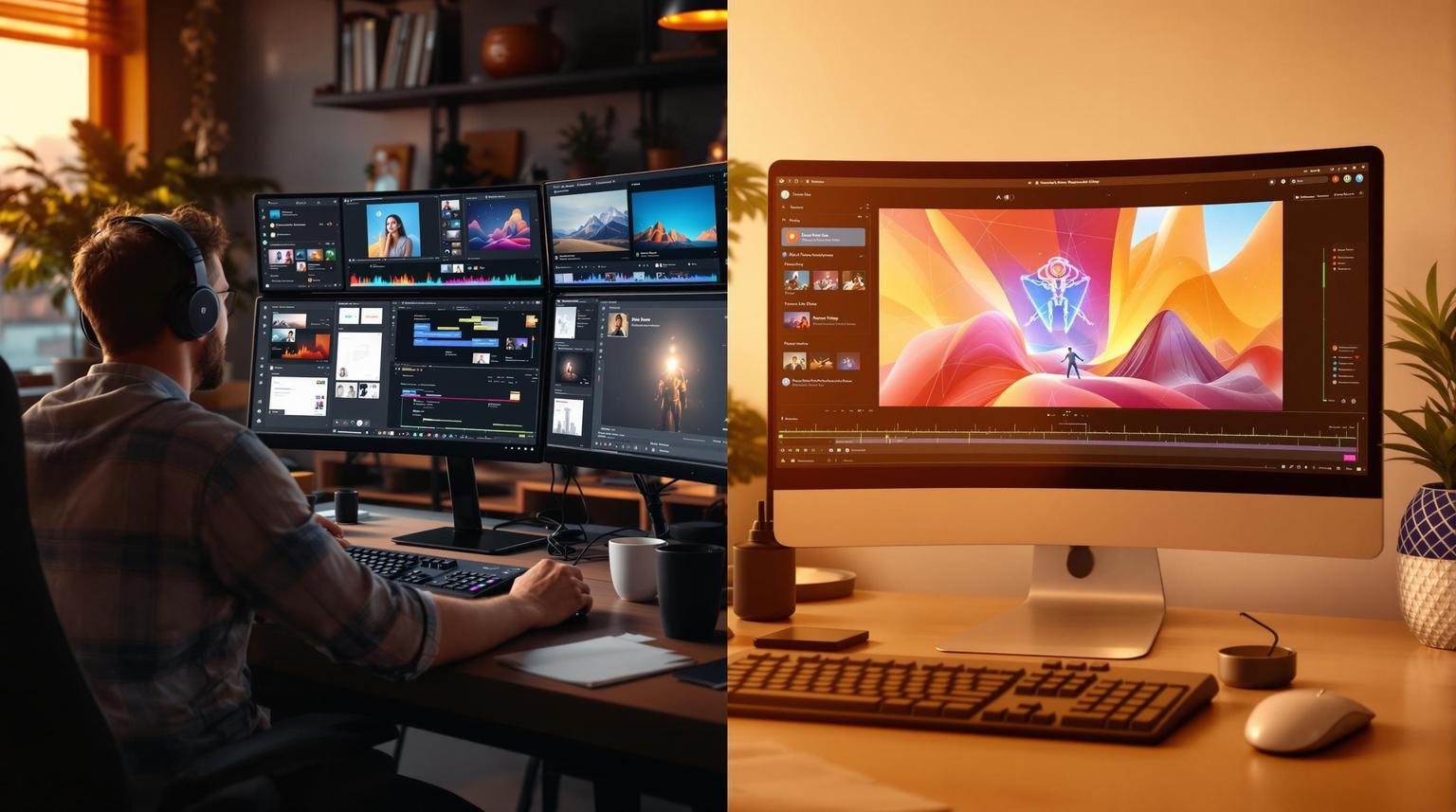
LongStories is constantly evolving as it finds its product-market fit. Features, pricing, and offerings are continuously being refined and updated. The information in this blog post reflects our understanding at the time of writing. Please always check LongStories.ai for the latest information about our products, features, and pricing, or contact us directly for the most current details.
AI vs Traditional Video Editing: What's Best for Your Business
AI video editing is fast, cost-effective, and great for repetitive tasks, while manual editing offers precision and creativity for complex projects. Choosing the right method depends on your business needs, such as deadlines, budget, and content type. Here's a quick comparison:
| Aspect | AI Editing | Manual Editing |
|---|---|---|
| Speed | Fast (minutes to hours) | Slow (days to weeks) |
| Cost | Lower, subscription-based | Higher, skilled labor required |
| Control | Automated, limited flexibility | Full creative freedom |
| Best Use Case | High-volume, simple projects | Detailed, intricate storytelling |
For most businesses, a hybrid approach works best: use AI for basic tasks and manual editing for creative refinement. This balances efficiency and quality, ensuring your content meets both production goals and audience expectations.
AI Video Editing - Top 5 Tools We Recommend in 2024
What Is AI Video Editing?
AI video editing uses machine learning to automate and simplify the video editing process. By analyzing video content and applying specific rules, it reduces the need for manual post-production work.
How AI Video Editing Works
These systems process raw footage frame by frame, identifying elements like scene changes, facial expressions, and key actions. Tasks such as scene detection, color adjustments, and audio syncing are handled automatically. AI tools often draw from professional editing techniques to apply them to new projects.
Examples of AI Video Editing Tools
Here are some popular AI-powered video editing tools tailored for different needs:
| Tool Name | Key Features | Best For |
|---|---|---|
| Adobe Premiere Pro (Sensei) | Smart reframing, auto-color correction, speech-to-text | Professional video production |
| CapCut Commerce Pro | Automated visual effects, style transfer, transition suggestions | Social media content |
| Unscript AI | Quick edits, scene detection, budget-friendly processing | Marketing videos |
Advantages of AI Video Editing
AI video editing offers businesses a way to improve efficiency in their video production workflows. Research from IBM Cloud Video shows that companies using AI tools can cut editing time by about 30%. By automating repetitive tasks like organizing scenes and adding captions, these tools make production faster and easier.
Some key benefits include:
- Faster turnaround times without needing advanced technical skills
- Consistent quality across projects
- Automatic subtitle creation and translation
For businesses, these advantages mean reduced costs, quicker delivery, and the ability to produce more content without sacrificing quality. However, manual editing still plays a role in projects that demand a creative or personal touch.
What Is Manual Video Editing?
Manual video editing relies on human skill and judgment to manage every detail of post-production. Unlike AI-powered tools, it focuses on creative decisions and meticulous control throughout the editing process.
How Manual Video Editing Works
This process involves hands-on work with professional software. Editors import footage, arrange clips, adjust transitions, and apply effects, all while carefully refining each element. It’s a time-intensive task that requires both technical expertise and an eye for detail, enabling editors to shape the exact story or message they want to convey.
Benefits of Manual Editing
Manual editing allows for complete control, enabling editors to make detailed adjustments that automated tools might overlook. This is especially important for projects that demand emotional depth or complex storytelling. The ability to make frame-by-frame decisions ensures a level of quality and craftsmanship that’s essential for high-profile or intricate projects.
Examples of Manual Editing Tools
Professional-grade software offers the tools editors need to produce polished, high-quality videos. Below are some top options and their standout features:
| Software | Key Features | Best For |
|---|---|---|
| Final Cut Pro | Excellent multicam editing | Film and TV production |
| Adobe Premiere Pro | Creative Suite integration | Commercial production |
| DaVinci Resolve | Advanced color correction tools | Color-sensitive projects |
These programs provide the control and flexibility necessary for professional results. While manual editing takes more time than AI-driven methods, it’s the go-to choice for projects where quality and creative vision take priority.
As businesses explore their editing options, understanding the balance between manual editing’s precision and AI’s speed can help them make informed decisions. How does manual editing measure up in terms of efficiency and scalability when compared to AI tools?
sbb-itb-94859ad
Comparing AI and Manual Video Editing
Understanding the differences between AI and manual video editing can guide businesses in choosing the best approach for their content production needs. Here's a breakdown of how these two methods compare in practice.
AI vs Manual Editing: Key Differences
| Aspect | AI Video Editing | Manual Video Editing |
|---|---|---|
| Speed | Fast (minutes to hours) | Slow (days to weeks) |
| Cost | Lower, often subscription-based | Higher, requires skilled labor |
| Quality Control | Automated consistency | Precise, human control |
| Learning Curve | Minimal training needed | Requires significant expertise |
| Scalability | Easily scalable | Limited by available resources |
These differences highlight the trade-offs between speed, cost, and creative control, helping businesses decide which approach best suits their goals.
Strengths and Weaknesses of AI Editing
For businesses focused on rapid content production, AI offers several advantages. Tools like Adobe Premiere Pro's Auto Reframe feature show how AI can streamline repetitive tasks and optimize workflows.
Key Strengths:
- Consistent results tailored for different platforms
- Pre-built templates for faster editing
- Lower costs, ideal for scaling production
- Automated processes ensure uniform quality
Notable Weaknesses:
- Limited ability to capture emotional depth
- Challenges with cultural nuances
- Less creative flexibility
- Potential inconsistencies with brand voice
Strengths and Weaknesses of Manual Editing
Manual editing remains the go-to choice for projects that demand creativity and detailed storytelling. It’s especially valuable for businesses focusing on high-quality brand narratives or complex video projects.
Key Strengths:
- Full creative control over every detail
- Perfect for intricate storytelling
- Adds emotional depth and tailored effects
- Ensures strong alignment with brand identity
Notable Weaknesses:
- Time-consuming process
- Higher costs due to skilled labor
- Difficult to scale quickly
- Requires experienced professionals
Choosing between AI and manual editing depends on your business needs. AI is ideal for speed and volume, while manual editing is better for precision and creativity. For instance, tools like Amazon Rekognition excel at automating tasks, while software like DaVinci Resolve is indispensable for advanced color grading and meticulous creative work.
How to Choose the Right Editing Method
Factors to Consider When Choosing
When deciding between AI and manual editing, several factors play a role in finding the best fit for your needs:
| Factor | Key Considerations |
|---|---|
| Timeline | Deadlines and required production volume |
| Budget | Available funds and long-term investments |
| Content Type | Platform-specific needs and complexity |
| Team Expertise | Skill levels and training capabilities |
| Quality Standards | Brand guidelines and audience demands |
These elements help determine whether AI's speed, manual precision, or a mix of both will work best for your projects.
When AI Editing Works Best
AI editing shines in scenarios such as:
- Quick-turnaround social media content
- High-volume, repetitive projects
- Situations with tight budgets or minimal resources
Platforms like LongStories.ai offer affordable options, starting at just $9/month, making professional editing tools accessible for regular creators.
When Manual Editing Is the Better Choice
There are times when manual editing is non-negotiable, including:
- Crafting detailed brand stories
- High-profile commercial campaigns
- Content that requires cultural sensitivity
- Projects demanding meticulous creative control
Software like DaVinci Resolve is particularly effective in these cases, especially when visual finesse is a priority.
Combining AI and Manual Editing
"For many content creators, AI is quickly becoming the go-to solution for video editing", says the London Daily News, "while maintaining the irreplaceable value of human creativity for more complex projects."
A hybrid approach blends the strengths of both methods:
- AI handles initial tasks like trimming and basic color adjustments.
- Manual editing adds creative touches and storytelling elements.
- Combine automated refinements with human oversight to ensure quality.
This approach allows businesses to scale production efficiently while keeping creative standards intact. By using AI for routine tasks and reserving manual expertise for critical details, companies can streamline their workflow without sacrificing quality.
Choosing the Right Editing Approach for Your Business
Both AI and manual editing have their own strengths, and the best choice depends on what your business needs most.
Comparing AI and Manual Editing
Video editing has come a long way, with AI-driven tools and manual editing each bringing something different to the table. AI tools like Runway ML and Adobe Premiere Pro's AI features handle repetitive tasks quickly, while software like DaVinci Resolve and Final Cut Pro provides the flexibility needed for more intricate, creative projects.
By combining the speed of AI with the creative touch of manual editing, businesses can enjoy a balanced workflow:
| Editing Method | Ideal For | Main Benefit |
|---|---|---|
| AI Editing | Social media clips, large-scale projects | Quick turnaround and efficiency |
| Manual Editing | Brand storytelling, high-end campaigns | Greater creative freedom and emotional depth |
| Hybrid Approach | Balancing volume and quality | Combines speed with creative finesse |
Practical Tips for Businesses
AI is great for scaling up production and handling routine tasks, while manual editing shines in crafting compelling narratives. A mix of the two can help you maintain both efficiency and quality.
As Simon Rajala from Creative Hub puts it:
"Human editors bring their own experiences to the story. They've lived, they've felt things, and they use all of that when they're telling the story"
When deciding on your approach, consider factors like:
- The amount of content you need to produce
- Your team's expertise and available tools
- The level of quality your audience expects
- The purpose and tone of your content
